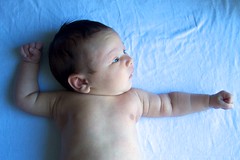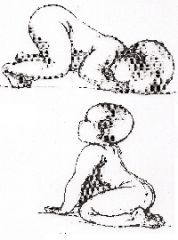![]()
![]()
![]()
Use LEFT and RIGHT arrow keys to navigate between flashcards;
Use UP and DOWN arrow keys to flip the card;
H to show hint;
A reads text to speech;
22 Cards in this Set
- Front
- Back
|
Rooting |
Turning the face towards touch (such as a stroke on the cheek) |
|
|
Suckle-swallow |
coordinates suck-swallow-breathe pattern when lips are touched to a finger or bottle |
|
|
Palmar grasp |
grasps an object when the palm is stroked |
|
|
Traction |
Co-contraction at the shoulder joint to move body with the force of whatever the child is holding onto |
|
|
Moro |
Lying down prone and feeling a loss of support the infant will extend arms to the side (horizontal abduction) and then return arms towards the midline (horizontal adduction) once stabilized. |
|
|
ATNR |

Asymmetrical tonic neck reflex is activated as a result of turning the head to one side. As the head is turned, the arm and leg on the same side will extend, while the opposite limbs bend. Known as "fencing" reflex. |
|
|
STNR |

Symmetrical tonic neck reflex - The neck extends when UE ext & LE flex. The neck flex when UE flex & LE ext. Called the "ape" walk. Effects tracking/vision. |
|
|
TLP |
Tonic labyrinthine reflex (TLR) - prone: increased flexion in the body when lying prone (face down). |
|
|
TLS |
Tonic labyrinthine reflex (TLR) - supine: increased extension in the body when lying supine (face up). |
|
|
Neck righting |
when lying supine and the head turns to the side the body will follow as a whole unit (i.e., "log fashion"). |
|
|
Body righting |
Lying supine and the head turned to the side the body will right itself by following the head in a segmented fashion (superior to inferior or vice versa). |
|
|
Labyrinthine Righting (vision occluded) |
Head aims to stay vertical to gravity based on the vestibular senses |
|
|
Optical righting |
Head aims to stay vertical based on optical senses |
|
|
RR vs ER |
RR = righting reaction (body rights itself by following the head) ER = equilibrium reaction (the body rights itself by rotating its weight around the center of gravity - think of balancing unequal weight on a teeter totter) |
|
|
Protective extension |
UE extend when falling forward |
|
|
Landau |
Supporting the child's trunk in prone position neck, BUE & BLE extend creating an arch. If head is pushed into flexion BLE will drop. |
|
|
Amphibian |
Involuntary flexion of arm, hip and knee when hip is lifted while lying prone. |
|
|
Placing of hand or foot |
Hand or foot lifts up and is placed on a supporting surface when positioned in front of one |
|
|
Primitive Walking |
Child involuntarily moves legs in a reciprocal walking pattern when held upright and "dragged" across the floor. |
|
|
Crossed extension |
Lying supine with one leg flexed, when the other is brought into flexion by external force the other leg pushes into extension. |
|
|
Flexor withdrawal |
Lying supine with both legs extended, when one leg is touched it will withdraw into flexion. |
|
|
Extensor thrust |
Lying supine with one leg flexed and touching the dorsal aspect (top) of the foot, the leg "shoots" into extension. |

